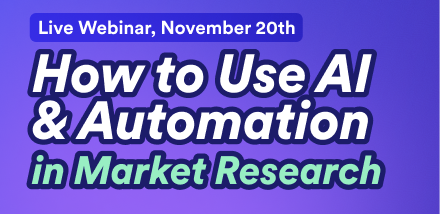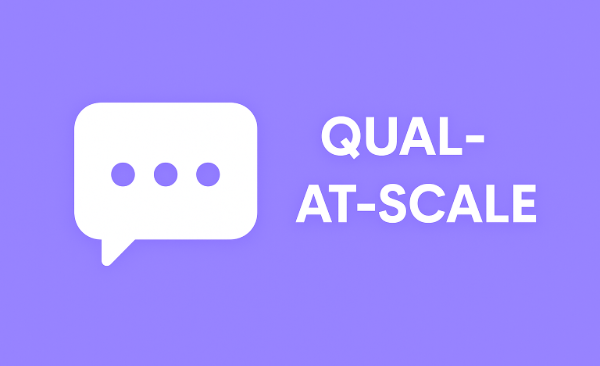You can divide research into one of two buckets. Either quantitative (measured with numbers) or qualitative (not measured with numbers).
Usually, quantitative research involves surveys and questionnaires, while qualitative is conducted using in-depth interviews, focus groups, or open-ended questions.
Each has its own unique advantages and disadvantages. Quantitative research produces structured data - making it easy to test, organize, and analyze. It is also usually considered to be faster, cheaper, and more scalable. Meanwhile, qualitative research delivers depth and a level of human understanding that you just don't get without asking open-ended questions.
Choosing between the methods has always involved a trade-off. But what if there were a way to access each of their benefits?
What is Qual-at-Scale?
As the name suggests, 'qual-at-scale' describes qualitative research performed and analyzed on a large scale. It has emerged as part of the shift towards AI-powered survey analysis.
The 'scale' part here is important, as this has always been one of the main restricting factors of qualitative research. Interviews take time. Transcribing and analyzing the findings from these interviews takes even longer. Likewise, manually reading, creating categories, and then classifying open-ended survey responses is incredibly time-consuming (not to mention error-prone).
Qual-at-scale has come as a result of advances in AI and text analytics. Natural language processing—the driving force behind generative AI—has made it possible to transcribe hours of interview recordings, read and analyze thousands of verbatims, or automatically create categories for text analysis in a matter of minutes.
Why Researchers Want Qual-at-Scale
So why is qual-at-scale proving so valuable? Ultimately, it's a way for researchers to deeply understand the wants and needs of individuals at scale. This helps them uncover richer insights, identify emerging themes faster, and make more human-centered decisions—without sacrificing speed or representativeness.
Other benefits of qual-at-scale for market researchers include:
- Effective capture of the voice of the customer: Rather than determining customers' views based on predetermined survey responses, qual-at-scale allows for the 'true' voice of the customer to be heard.
- Cost efficiency: Automating labor-intensive qualitative processes dramatically reduces the cost per insight, making in-depth analysis more accessible and scalable.
- Continuous model improvement through human supervision: With researchers reviewing and refining AI outputs, the system learns and improves over time—leading to more accurate, relevant, and useful results.
- Reducing manual effort: AI-powered text analytics automates traditionally time-consuming tasks like transcription, coding, and categorization, freeing up researchers to focus on interpretation and storytelling.
Example of Qual-at-Scale
You can find an example of how qual-at-scale can be put to use if you ever go to cancel your Netflix subscription. After completing the cancellation, you go to a standard exit questionnaire, which will ask why you decided to cancel your membership. There are a number of standard options to choose from, as well as an 'other' box, which encourages open-ended responses.
Even with one of the lowest churn rates in the industry (approximately 2%), Netflix still has thousands of subscribers canceling their membership each year. Although we don't know exactly what the streaming giant does with this open-ended data, we can assume that by encouraging open-ended feedback, it can gather deeper insight into why customers churn.
This might involve identifying new themes as they emerge or quickly spotting shifts in customer sentiment. Using qual-at-scale, Netflix can then refine its content strategy, improve user experience, and proactively address issues, all based on the qualitative analysis of this unstructured data.
Qual-at-Scale Best Practices
Although the concept of AI-powered qual-at-scale is relatively new, we can apply much of what we already know about data analysis and AI to follow some best practices. For example;
- Keep humans in the loop: As we move further down the line with AI and market research, it is becoming increasingly clear that human collaboration is a must. What this looks like will vary from project to project, however, it is important to have someone verify the accuracy of any AI-generated results.
- Use prompts effectively: When prompting, ensure they are clear, specific, and concise. Extra details, such as providing examples or breaking up the request step-by-step, will further improve the effectiveness. More details on prompting best practices can be found here.
- Combine quant and qual where possible: Advances in AI are eroding the distinction between quant and qual. Large-scale qualitative analysis should be used in combination with statistical analysis, where possible, to ensure a greater depth of understanding.
- Visualize the findings: Wordclouds - despite their drawbacks - have traditionally been the visualization of choice for open-ended data. However, with qual-at-scale making it easier to quickly assign a numeric value to free-form data (e.g., sentiment scoring), it is easier to use standard visualizations such as bar charts, sankey diagrams, and so on.
Try Displayr AI
AI is transforming the way researchers work—making it faster and easier to uncover insights from even the most complex data. Whether you're working with open-ended responses, survey data, or anything in between, Displayr helps you harness the power of AI to analyze it all in one place. If you're ready to work smarter and dig deeper, it's worth exploring what's possible with Displayr AI.


